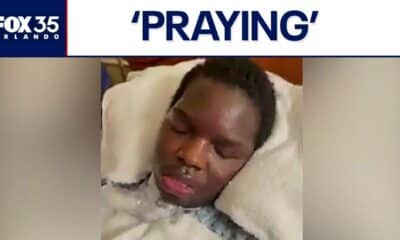Kaiser Health News
Most Americans Say They or a Family Member Has Experienced Gun Violence
by Liz Szabo, Kaiser Health News
Tue, 11 Apr 2023 09:01:00 +0000
A majority of Americans say they or a family member has experienced gun violence, such as witnessing a shooting, being threatened by a person with a gun, or being shot, according to a sweeping new survey.
The national survey of 1,271 adults conducted by KFF revealed the severe physical and psychological harm exacted by firearm violence, especially in minority communities.
Nearly 1 in 5 respondents , including 34% of Black adults, 18% of Hispanic adults, and 17% of white adults, said a family member had been killed by a gun.
The survey “confirms that firearm-related injuries are ubiquitous,” said Dr. Selwyn Rogers, a surgeon and founding director of the UChicago Medicine trauma center. “For every person killed, there are two or three people harmed. These are people who have had fractures, who may have been paralyzed or disabled.”
Beyond causing physical injuries, gun violence has left many Americans living with trauma and fear, Rogers said.
Just over half of adults say gun-related crimes, injuries, and deaths are a “constant threat” or “major concern” in their communities. Black and Hispanic adults were more likely than white adults to describe gun violence as a constant threat or major concern. About 3 in 10 Black or Hispanic adults say they feel “not too safe” or “not safe at all” from gun violence in their neighborhoods. (Hispanics can be of any race or combination of races.)
Women also reported high rates of concern about firearm violence, with 58% saying gun-related crimes are a constant threat or major concern, compared with 43% of men. More than half of intimate partner homicides are committed with guns.
Parents are worried about their children as well.
About 1 in 4 parents of children under 18 say they worry daily or almost daily about gun violence, the KFF survey found, and 84% of adults report having taken at least one precaution to reduce their family’s risk from gun violence. More than one-third of adults say they have avoided large crowds, such as at music festivals or crowded bars, for example.
Gun violence surged during the pandemic. There were a record 48,830 firearm-related deaths in 2021, an increase of 23% from 2019, according to an analysis by the Pew Research Center. The increase among children was even sharper. Firearm deaths among Americans under 18 — which include those due to homicide, suicide, and gun-related accidents — increased 50%, from 1,732 in 2019 to 2,590 in 2021.
Guns have become the leading cause of death among children and adolescents ages 1 to 19, according to the Centers for Disease Control and Prevention.
The pandemic also coincided with a huge increase in gun purchases, which grew an estimated 64% from 2019 to 2020.
According to the KFF survey, 29% of adults have purchased a gun at some point to protect themselves or their families, with 44% of parents of children under 18 keeping a gun in the home. Yet 78% of parents in gun-owning households fail to follow safety recommendations, such as locking guns and ammunition, storing guns unloaded, and storing guns and ammunition separately, practices that have been shown to reduce the risk of thefts, accidents, and suicides.
Dr. Abdullah Pratt, an emergency physician at the UChicago Medicine trauma center, has lost a dozen close friends to gun violence, including his brother. His father never recovered from that loss and died about seven years later, at age 64.
“As soon as my brother got killed, he stopped taking his medications and started chain-smoking out of nowhere,” Pratt said.
Gun violence also wears away communities, Pratt said.
In neighborhoods with high crime rates, the daily drumbeat of loss can lead residents to conclude there’s no point in voting, going to school, or trying to improve their lives. “They think, ‘What am I voting for if I can’t have basic access to safety on a day-to-day basis?’” Pratt said.
And while mass shootings and homicides grab headlines, Rogers, the surgeon, noted that suicides account for more than half of firearm-related deaths in the U.S. and cause ripples of grief throughout a community. Researchers estimate that every suicide leaves at least six people in mourning.
Pratt said he feels guilty he wasn’t able to help a close friend who died by suicide with a gun several years ago. The man had recently lost a job and had his car repossessed and came to Pratt to talk about his troubles. Instead, Pratt spent the visit asking for parenting advice, without realizing how much his friend was hurting.
“There were no red flags,” Pratt said. “A couple days later, he died.”
Gun violence has also shaped the trajectory of Bernice Grisby’s life.
Grisby, now 35, was shot for the first time when she was 8, while playing on the swings at her school in Oakland, California. She was shot a second time at age 15, when she was talking to friends after school. One of her friends died that day, while another lost an eye; Grisby was shot in the hip and experiences chronic pain from the wound.
Two of her brothers were fatally shot in their 20s. Her 15-year-old daughter was recently robbed at gunpoint.
Rather than leaving Oakland, Grisby is trying to save it. She works as a street counselor to young people at high risk of gun violence through Oakland’s East Bay Asian Youth Center, which aims to help young people living in poverty, trauma, and neglect.
“My life is a gift from God,” Grisby said. “I am happy to be here to support the youth and know that I am making a difference.”
By: Liz Szabo, Kaiser Health News
Title: Most Americans Say They or a Family Member Has Experienced Gun Violence
Sourced From: kffhealthnews.org/news/article/kff-survey-gun-violence-majority-of-americans/
Published Date: Tue, 11 Apr 2023 09:01:00 +0000
Did you miss our previous article…
https://www.biloxinewsevents.com/doctor-shortages-distress-rural-america-where-few-residency-programs-exist/
Kaiser Health News
Alabama Can’t Prosecute Groups Helping Patients Get Abortions Elsewhere, Judge Rules
Reproductive rights groups in Alabama wasted no time resuming their work after a federal judge ruled in early April that the state’s attorney general can’t prosecute — or threaten to prosecute — people or organizations who help Alabama residents seek an abortion by traveling to another state.
One of the plaintiffs, the reproductive justice nonprofit Yellowhammer Fund, wasted no time in returning to one of its core missions: to provide financial support to traveling patients.
“The decision came at about 5:30. I think we funded an abortion at 5:45 — because that’s how severe the need is, that’s how urgent it is that we get back to the work that we’re doing,” said Jenice Fountain, executive director of Yellowhammer Fund, which advocates for abortion access.
On April 2, the U.S. Supreme Court heard oral arguments on whether South Carolina can remove Planned Parenthood clinics from the state’s Medicaid program. This came just days after Planned Parenthood received notice that the Trump administration would withhold funding from the Title X Family Planning Program for nine of the group’s affiliates.
“We’re just seeing kind of a multiplying of conflicts where we have unanswered questions about the meaning of the First Amendment in this context, about the right to travel in this context, about due process in this context — about these sort of clashing state laws and choosing which one applies,” said Mary Ziegler, a law professor at the University of California-Davis who specializes in the politics and history of reproductive rights.
Alabama has one of the strictest bans on abortion in the country — with no exceptions for rape or incest. The law was approved by the state legislature in 2019 and remained at the ready should Roe v. Wade be overturned. It took effect immediately when the Supreme Court did just that on June 24, 2022, in the Dobbs v. Jackson Women’s Health Organization decision.
At the time, Yellowhammer Fund was getting about 100 calls a week from people seeking financial help with getting an abortion, Fountain said.
For more than two years, the organization has been unable to help such callers.
“The thing with the ban was it was so vague that it was incredibly hard to interpret, especially if you weren’t a person that was legally inclined,” Fountain said. “So the effect that it had, which was its intention, was a chilling effect.”
During that time, Yellowhammer continued to promote reproductive justice and maternal and infant health through community efforts such as distributing diapers, formula, menstrual supplies, and emergency contraception.
Beyond the alarm created by the statutory language in Alabama’s abortion ban, fears were stoked by Alabama’s attorney general, Steve Marshall, Fountain said.
Almost seven weeks after the 2022 Dobbs decision, Marshall said in a radio interview that groups that assist people seeking an abortion in another state could face criminal prosecution.
“There’s no doubt that this is a criminal law and the general principles that apply to a criminal law would apply to this, with its status of the Class A felony, that’s the most significant offense that we have as far as punishment goes under our criminal statue, absent a death penalty case,” Marshall said in the interview with Breitbart TV editor Jeff Poor.
“If someone was promoting themselves out as a funder of abortion out of state, then that is potentially criminally actionable for us,” Marshall said.
Marshall was explicitly referring to such groups as Yellowhammer Fund, Fountain said.
“He mentioned the group from Tuscaloosa that helps people get to care, which is Yellowhammer Fund,” Fountain said. “He all but ‘@’d us.”
Yellowhammer Fund and other abortion rights groups filed the lawsuit against Marshall on July 31, 2023.
In his ruling, U.S. District Judge Myron Thompson of the Middle District of Alabama in Montgomery, agreed with them, saying Marshall would be violating both First Amendment free speech rights and the constitutional right to travel if he tried to bring criminal charges.
Thompson also warned against overlooking the “broader, practical implications of the Attorney General’s threats,” in the matter of Alabama trying to enforce laws outside the state.
“For example,” Thompson wrote in his ruling, “the Alabama Attorney General would have within his reach the authority to prosecute Alabamians planning a Las Vegas bachelor party, complete with casinos and gambling, since casino-style gambling is outlawed in Alabama.”
Another group involved in the case, WAWC Healthcare in Tuscaloosa (formerly West Alabama Women’s Center), also resumed work that had been paused.
“We have spent the last few years worried that if we had provided any form of information to patients about where they could access a legal abortion, that that is something that the attorney general might try to prosecute us over,” said Robin Marty, WAWC’s executive director.
Before the Dobbs decision, WAWCprovided abortion as part of its services. It continues to offer free reproductive health care, including prenatal care, contraception, and HIV testing.
Clinical staffers at WAWC weren’t allowed even to suggest to someone that they could leave the state to get an abortion, Marty said.
“There is nothing harder than looking into somebody’s face when they are in crisis and saying, ‘I’m sorry, I just can’t help you anymore,’” Marty said. “That was really wearing on my staff because our job was to provide the best information possible. And to know that we could not give them the full care that they required was heartbreaking.”
With the ruling, WAWC can now offer “all-options counseling,” which includes information on how and where patients can access abortion services in other states, Marty said.
“If they do not feel like they are able to continue the pregnancy, we can tell them, ‘OK, you are this far along, so you are able to go this clinic in North Carolina, because you’re under their limit” for gestational age, “or you can go to this clinic in Illinois because you’re under their limit,’” Marty said. “We’ll be able to tell them exactly where they can go and even be able to help them with the referral process along the way.”
The attorney general could file an appeal, but now it’s unclear whether his office will do so. Marshall’s office did not respond to NPR’s request for an interview, but in a statement said, “The office is reviewing the decision to determine the state’s options.”
But legal expert Ziegler said she’d be surprised if Marshall didn’t file an appeal, given his office’s vigorous defense in the lawsuit.
In addition, the potential political costs of pursuing that kind of prosecution may have eased, because states like Texas and Louisiana have already taken legal action regarding out-of-state abortion providers, said Ziegler.
On the other hand, the attorney general might not appeal because his office was the defendant in the lawsuit, and he may not want to draw attention to the case, Ziegler said.
If Marshall did file an appeal, it would go to the U.S. Court of Appeals for the 11th Circuit, which Ziegler called conservative-leaning. The case could ultimately go to the U.S. Supreme Court, Ziegler said, which may have to weigh in more on abortion-related cases, such as when it temporarily allowed emergency abortions in Idaho in June 2024.
“I think the takeaway is that the U.S. Supreme Court is going to be more involved than ever in fights about reproduction and abortion, not less, notwithstanding the fact that Roe is gone,” Ziegler said.
This article is from a partnership that includes Gulf States Newsroom, NPR and KFF Health News.
KFF Health News is a national newsroom that produces in-depth journalism about health issues and is one of the core operating programs at KFF—an independent source of health policy research, polling, and journalism. Learn more about KFF.
Subscribe to KFF Health News’ free Morning Briefing.
This article first appeared on KFF Health News and is republished here under a Creative Commons license.
The post Alabama Can’t Prosecute Groups Helping Patients Get Abortions Elsewhere, Judge Rules appeared first on kffhealthnews.org
Note: The following A.I. based commentary is not part of the original article, reproduced above, but is offered in the hopes that it will promote greater media literacy and critical thinking, by making any potential bias more visible to the reader –Staff Editor.
Political Bias Rating: Left-Leaning
The content strongly supports reproductive rights, focusing on the challenges faced by organizations that assist women seeking abortions and the legal efforts to overturn restrictive state laws. The tone is sympathetic to the abortion rights movement, highlighting the urgency and emotional impact of the work done by organizations like the Yellowhammer Fund and WAWC. The inclusion of legal experts and references to actions taken by conservative states, particularly Alabama’s attorney general, further emphasizes the ideological divide on abortion issues. While it presents factual events, the framing and choice of language favor a pro-abortion rights perspective.
Kaiser Health News
US Judge Names Receiver To Take Over California Prisons’ Mental Health Program
SACRAMENTO, Calif. — A judge has initiated a federal court takeover of California’s troubled prison mental health system by naming the former head of the Federal Bureau of Prisons to serve as receiver, giving her four months to craft a plan to provide adequate care for tens of thousands of prisoners with serious mental illness.
Senior U.S. District Judge Kimberly Mueller issued her order March 19, identifying Colette Peters as the nominated receiver. Peters, who was Oregon’s first female corrections director and known as a reformer, ran the scandal-plagued federal prison system for 30 months until President Donald Trump took office in January. During her tenure, she closed a women’s prison in Dublin, east of Oakland, that had become known as the “rape club.”
Michael Bien, who represents prisoners with mental illness in the long-running prison lawsuit, said Peters is a good choice. Bien said Peters’ time in Oregon and Washington, D.C., showed that she “kind of buys into the fact that there are things we can do better in the American system.”
“We took strong objection to many things that happened under her tenure at the BOP, but I do think that this is a different job and she’s capable of doing it,” said Bien, whose firm also represents women who were housed at the shuttered federal women’s prison.
California corrections officials called Peters “highly qualified” in a statement, while Gov. Gavin Newsom’s office did not immediately comment. Mueller gave the parties until March 28 to show cause why Peters should not be appointed.
Peters is not talking to the media at this time, Bien said. The judge said Peters is to be paid $400,000 a year, prorated for the four-month period.
About 34,000 people incarcerated in California prisons have been diagnosed with serious mental illnesses, representing more than a third of California’s prison population, who face harm because of the state’s noncompliance, Mueller said.
Appointing a receiver is a rare step taken when federal judges feel they have exhausted other options. A receiver took control of Alabama’s correctional system in 1976, and they have otherwise been used to govern prisons and jails only about a dozen times, mostly to combat poor conditions caused by overcrowding. Attorneys representing inmates in Arizona have asked a judge to take over prison health care there.
Mueller’s appointment of a receiver comes nearly 20 years after a different federal judge seized control of California’s prison medical system and installed a receiver, currently J. Clark Kelso, with broad powers to hire, fire, and spend the state’s money.
California officials initially said in August that they would not oppose a receivership for the mental health program provided that the receiver was also Kelso, saying then that federal control “has successfully transformed medical care” in California prisons. But Kelso withdrew from consideration in September, as did two subsequent candidates. Kelso said he could not act “zealously and with fidelity as receiver in both cases.”
Both cases have been running for so long that they are now overseen by a second generation of judges. The original federal judges, in a legal battle that reached the U.S. Supreme Court, more than a decade ago forced California to significantly reduce prison crowding in a bid to improve medical and mental health care for incarcerated people.
State officials in court filings defended their improvements over the decades. Prisoners’ attorneys countered that treatment remains poor, as evidenced in part by the system’s record-high suicide rate, topping 31 suicides per 100,000 prisoners, nearly double that in federal prisons.
“More than a quarter of the 30 class-members who died by suicide in 2023 received inadequate care because of understaffing,” prisoners’ attorneys wrote in January, citing the prison system’s own analysis. One prisoner did not receive mental health appointments for seven months “before he hanged himself with a bedsheet.”
They argued that the November passage of a ballot measure increasing criminal penalties for some drug and theft crimes is likely to increase the prison population and worsen staffing shortages.
California officials argued in January that Mueller isn’t legally justified in appointing a receiver because “progress has been slow at times but it has not stalled.”
Mueller has countered that she had no choice but to appoint an outside professional to run the prisons’ mental health program, given officials’ intransigence even after she held top officials in contempt of court and levied fines topping $110 million in June. Those extreme actions, she said, only triggered more delays.
The 9th U.S. Circuit Court of Appeals on March 19 upheld Mueller’s contempt ruling but said she didn’t sufficiently justify calculating the fines by doubling the state’s monthly salary savings from understaffing prisons. It upheld the fines to the extent that they reflect the state’s actual salary savings but sent the case back to Mueller to justify any higher penalty.
Mueller had been set to begin additional civil contempt proceedings against state officials for their failure to meet two other court requirements: adequately staffing the prison system’s psychiatric inpatient program and improving suicide prevention measures. Those could bring additional fines topping tens of millions of dollars.
But she said her initial contempt order has not had the intended effect of compelling compliance. Mueller wrote as far back as July that additional contempt rulings would also be likely to be ineffective as state officials continued to appeal and seek delays, leading “to even more unending litigation, litigation, litigation.”
She went on to foreshadow her latest order naming a receiver in a preliminary order: “There is one step the court has taken great pains to avoid. But at this point,” Mueller wrote, “the court concludes the only way to achieve full compliance in this action is for the court to appoint its own receiver.”
This article was produced by KFF Health News, which publishes California Healthline, an editorially independent service of the California Health Care Foundation.
If you or someone you know may be experiencing a mental health crisis, contact the 988 Suicide & Crisis Lifeline by dialing or texting “988.”
The post US Judge Names Receiver To Take Over California Prisons’ Mental Health Program appeared first on kffhealthnews.org
Kaiser Health News
Amid Plummeting Diversity at Medical Schools, a Warning of DEI Crackdown’s ‘Chilling Effect’
The Trump administration’s crackdown on DEI programs could exacerbate an unexpectedly steep drop in diversity among medical school students, even in states like California, where public universities have been navigating bans on affirmative action for decades. Education and health experts warn that, ultimately, this could harm patient care.
Since taking office, President Donald Trump has issued a handful of executive orders aimed at terminating all diversity, equity, and inclusion, or DEI, initiatives in federally funded programs. And in his March 4 address to Congress, he described the Supreme Court’s 2023 decision banning the consideration of race in college and university admissions as “brave and very powerful.”
Last month, the Education Department’s Office for Civil Rights — which lost about 50% of its staff in mid-March — directed schools, including postsecondary institutions, to end race-based programs or risk losing federal funding. The “Dear Colleague” letter cited the Supreme Court’s decision.
Paulette Granberry Russell, president and CEO of the National Association of Diversity Officers in Higher Education, said that “every utterance of ‘diversity’ is now being viewed as a violation or considered unlawful or illegal.” Her organization filed a lawsuit challenging Trump’s anti-DEI executive orders.
While California and eight other states — Arizona, Florida, Idaho, Michigan, Nebraska, New Hampshire, Oklahoma, and Washington — had already implemented bans of varying degrees on race-based admissions policies well before the Supreme Court decision, schools bolstered diversity in their ranks with equity initiatives such as targeted scholarships, trainings, and recruitment programs.
But the court’s decision and the subsequent state-level backlash — 29 states have since introduced bills to curb diversity initiatives, according to data published by the Chronicle of Higher Education — have tamped down these efforts and led to the recent declines in diversity numbers, education experts said.
After the Supreme Court’s ruling, the numbers of Black and Hispanic medical school enrollees fell by double-digit percentages in the 2024-25 school year compared with the previous year, according to the Association of American Medical Colleges. Black enrollees declined 11.6%, while the number of new students of Hispanic origin fell 10.8%. The decline in enrollment of American Indian or Alaska Native students was even more dramatic, at 22.1%. New Native Hawaiian or other Pacific Islander enrollment declined 4.3%.
“We knew this would happen,” said Norma Poll-Hunter, AAMC’s senior director of workforce diversity. “But it was double digits — much larger than what we anticipated.”
The fear among educators is the numbers will decline even more under the new administration.
At the end of February, the Education Department launched an online portal encouraging people to “report illegal discriminatory practices at institutions of learning,” stating that students should have “learning free of divisive ideologies and indoctrination.” The agency later issued a “Frequently Asked Questions” document about its new policies, clarifying that it was acceptable to observe events like Black History Month but warning schools that they “must consider whether any school programming discourages members of all races from attending.”
“It definitely has a chilling effect,” Poll-Hunter said. “There is a lot of fear that could cause institutions to limit their efforts.”
Numerous requests for comment from medical schools about the impact of the anti-DEI actions went unreturned. University presidents are staying mum on the issue to protect their institutions, according to reporting from The New York Times.
Utibe Essien, a physician and UCLA assistant professor, said he has heard from some students who fear they won’t be considered for admission under the new policies. Essien, who co-authored a study on the effect of affirmative action bans on medical schools, also said students are worried medical schools will not be as supportive toward students of color as in the past.
“Both of these fears have the risk of limiting the options of schools folks apply to and potentially those who consider medicine as an option at all,” Essien said, adding that the “lawsuits around equity policies and just the climate of anti-diversity have brought institutions to this place where they feel uncomfortable.”
In early February, the Pacific Legal Foundation filed a lawsuit against the University of California-San Francisco’s Benioff Children’s Hospital Oakland over an internship program designed to introduce “underrepresented minority high school students to health professions.”
Attorney Andrew Quinio filed the suit, which argues that its plaintiff, a white teenager, was not accepted to the program after disclosing in an interview that she identified as white.
“From a legal standpoint, the issue that comes about from all this is: How do you choose diversity without running afoul of the Constitution?” Quinio said. “For those who want diversity as a goal, it cannot be a goal that is achieved with discrimination.”
UC Health spokesperson Heather Harper declined to comment on the suit on behalf of the hospital system.
Another lawsuit filed in February accuses the University of California of favoring Black and Latino students over Asian American and white applicants in its undergraduate admissions. Specifically, the complaint states that UC officials pushed campuses to use a “holistic” approach to admissions and “move away from objective criteria towards more subjective assessments of the overall appeal of individual candidates.”
The scrutiny of that approach to admissions could threaten diversity at the UC-Davis School of Medicine, which for years has employed a “race-neutral, holistic admissions model” that reportedly tripled enrollment of Black, Latino, and Native American students.
“How do you define diversity? Does it now include the way we consider how someone’s lived experience may be influenced by how they grew up? The type of school, the income of their family? All of those are diversity,” said Granberry Russell, of the National Association of Diversity Officers in Higher Education. “What might they view as an unlawful proxy for diversity equity and inclusion? That’s what we’re confronted with.”
California Attorney General Rob Bonta, a Democrat, recently joined other state attorneys general to issue guidance urging that schools continue their DEI programs despite the federal messaging, saying that legal precedent allows for the activities. California is also among several states suing the administration over its deep cuts to the Education Department.
If the recent decline in diversity among newly enrolled students holds or gets worse, it could have long-term consequences for patient care, academic experts said, pointing toward the vast racial disparities in health outcomes in the U.S., particularly for Black people.
A higher proportion of Black primary care doctors is associated with longer life expectancy and lower mortality rates among Black people, according to a 2023 study published by the JAMA Network.
Physicians of color are also more likely to build their careers in medically underserved communities, studies have shown, which is increasingly important as the AAMC projects a shortage of up to 40,400 primary care doctors by 2036.
“The physician shortage persists, and it’s dire in rural communities,” Poll-Hunter said. “We know that diversity efforts are really about improving access for everyone. More diversity leads to greater access to care — everyone is benefiting from it.”
This article was produced by KFF Health News, which publishes California Healthline, an editorially independent service of the California Health Care Foundation.
The post Amid Plummeting Diversity at Medical Schools, a Warning of DEI Crackdown’s ‘Chilling Effect’ appeared first on kffhealthnews.org
-

 Mississippi Today7 days ago
Mississippi Today7 days agoTrump appoints former Gov. Phil Bryant to FEMA Review Council as state awaits ruling on tornadoes
-

 News from the South - Alabama News Feed7 days ago
News from the South - Alabama News Feed7 days ago7-Year-Old Calls 911, Helps Save Family Member's Life | April 28, 2025 | News 19 at 10 p.m.
-

 News from the South - Florida News Feed5 days ago
News from the South - Florida News Feed5 days agoFlorida teen awakens from coma months after scooter crash
-

 News from the South - Louisiana News Feed5 days ago
News from the South - Louisiana News Feed5 days agoProposed amendment could allow lawmakers to remove protected state jobs | Louisiana
-

 News from the South - Georgia News Feed7 days ago
News from the South - Georgia News Feed7 days agoGeorgia police cope with deaths of two officers | FOX 5 News
-

 News from the South - Oklahoma News Feed7 days ago
News from the South - Oklahoma News Feed7 days agoTracking tornado-warned storms near Altus
-

 News from the South - West Virginia News Feed3 days ago
News from the South - West Virginia News Feed3 days agoSmall town library in WV closes after 50 years
-

 News from the South - Tennessee News Feed6 days ago
News from the South - Tennessee News Feed6 days agoMan gets another chance after shooting case dropped

















































